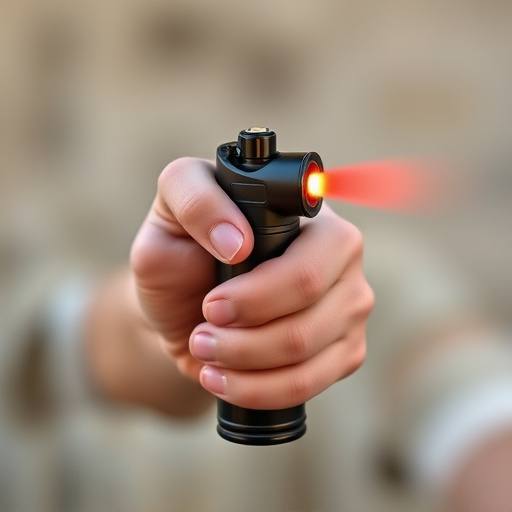OC spray, a self-defense mechanism using capsaicin from chili peppers, is effective against attackers but its power depends on concentration levels (1%-20%). For legal safety and to minimize harm, it's crucial to understand local laws and use guidelines. Targeting attackers' faces with a fine mist at the right distance enhances effectiveness while proper training ensures responsible deployment and prevents adverse effects.
“OC Spray, a powerful non-lethal self-defense tool, harnesses the heat of capsicin to deter attackers. This article delves into the world of OC Spray, exploring its active ingredient, capsaicin concentration levels, and their impact on effectiveness. We also navigate legal considerations, deployment techniques, and safety precautions, providing insights for responsible usage. Understand the power behind this defense tool, especially when comparing different capsicin concentrations, to make informed decisions in potentially dangerous situations.”
- Understanding OC Spray: A Non-Lethal Self-Defense Option
- Capsaicin Concentration: The Power Behind the Spray
- Legal Considerations and Usage Guidelines
- Effective Deployment Techniques and Safety Precautions
Understanding OC Spray: A Non-Lethal Self-Defense Option
OC spray, also known as oleoresin capsicum (OC) spray, is a non-lethal self-defense tool that uses capsaicin, the active ingredient found in chili peppers, to disable and incapacitate an attacker temporarily. Unlike firearms or other lethal force options, OC spray is designed to minimize harm while providing users with time to escape or seek help. The effectiveness of OC spray lies in its capsicum concentration levels, which range from 1% to 20%, depending on the brand and intended use. Higher concentrations deliver a stronger sting and longer-lasting effects, making them suitable for more intense situations.
OC spray works by causing a burning sensation and inflammation in the eyes, nose, throat, and skin of the target individual. This irritant response disrupts balance and coordination, temporarily blinding the attacker and disorienting them long enough for the user to retreat or summon assistance. It’s important to note that while OC spray is a valuable tool for personal safety, users must be trained in its proper application to ensure maximum effectiveness and minimize accidental harm.
Capsaicin Concentration: The Power Behind the Spray
The effectiveness of oleoresin capsicum (OC) spray as a defense tool lies in its capsaicin concentration levels. Capsaicin, the active ingredient in chili peppers, is responsible for the burning sensation felt when exposed to OC spray. The power of this spray varies depending on the percentage of capsaicin it contains. Typically, OC spray capsaicin concentration levels range from 1% to 2%, making it potent enough to cause temporary blindness and disorientation in assailants without causing serious harm.
At these concentrations, OC spray disrupts the nerve signals that transmit pain and temperature information to the brain, creating a powerful deterrent. This temporary disruption is crucial for individuals looking to defend themselves, providing them with precious time to escape or seek help. Moreover, the specific capsaicin concentration ensures that the spray remains non-lethal, aligning it with legal standards for personal defense tools.
Legal Considerations and Usage Guidelines
When considering oleoresin capsicum (OC) spray as a defense tool, it’s crucial to understand legal considerations and usage guidelines. Each jurisdiction has specific laws regarding the possession and use of OC spray, with regulations varying widely in terms of capsaicin concentration levels permitted for civilian use. High-strength OC sprays containing up to 10% capsaicin are common, but only authorized individuals or those operating under specific circumstances should deploy such potent agents.
Usage guidelines emphasize responsible and proportionate application. OC spray should only be used as a last resort when facing imminent physical harm. Misuse or excessive deployment can result in serious adverse effects on the target’s health and well-being. Users must be trained to ensure accurate targeting, minimizing off-target impact and potential bystander injuries. Adhering to these legal considerations and usage guidelines is essential for ensuring safety and avoiding legal repercussions.
Effective Deployment Techniques and Safety Precautions
When deploying oleoresin capsicum (OC) spray, understanding effective techniques is key to its success as a defense tool. Aiming at the attacker’s face and eyes is the most immediate and powerful method, as occlusions in these areas can temporarily neutralize the threat. A fine mist application allows for better coverage, ensuring that capsaicin gets into the attacker’s respiratory system, causing coughing, breathing difficulties, and disorientation. Practice target acquisition and be mindful of distance, wind direction, and environmental conditions to maximize accuracy and effectiveness.
Safety precautions are paramount when using OC spray. Always ensure you have a clear understanding of local regulations and legal implications surrounding its use. Users should wear protective eyewear and clothing to minimize exposure to capsaicin themselves. Keep the spray can out of reach of children and store it in a secure, labeled location. Be aware of potential cross-contamination issues and wash hands thoroughly after each use. Additionally, be mindful of any individuals with medical conditions that could be exacerbated by capsaicin exposure, and avoid using the spray in close proximity to such individuals.
OC spray, powered by capsaicin concentration levels, offers a non-lethal self-defense option with strategic deployment techniques. Understanding the active ingredient’s power and legal considerations is crucial for responsible usage. By adhering to guidelines and safety precautions, individuals can effectively utilize OC spray as a personal defense tool in various situations.
